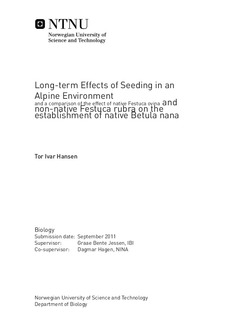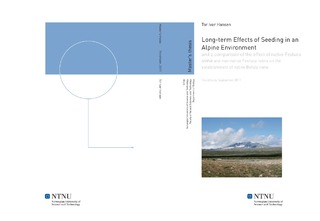| dc.description.abstract | As human induced disturbance in alpine ecosystems have increased, more knowledge is needed about the long-term effects of restoration efforts in such environments. There are benefits with using native species in restoration in alpine ecosystems, but the establishment success of native species compared to non-native species, and their effect on the establishment of native species has not been evaluated in detail. We examined ten disturbed alpine sites 21 years after seeding with a commercial seed mix, with regard to vegetation cover, species richness and soil conditions, and compared them with reference sites in close vicinity. After 21 years seeded sites had more vegetation cover, but native vegetation cover and species richness was larger in reference sites. Soil material did have a significant effect on vegetation cover, with less vegetation establishing as dominating soil particle size increased. However, native vegetation cover remained the same with increasing soil material. The effects of a native species, Festuca ovina, was compared with the effects of the main ingredient from the commercial seed mix used in 1989, Festuca rubra, on the establishment of the native Betula nana. Festuca rubra established slightly better than F. ovina on all soil types in the greenhouse experiment, but had larger plant size. B. nana experienced competition from both Festuca species, but less from F. ovina. The species F. ovina facilitated for B. nana on coarse soil. Even though these findings indicate that the native F. ovina is the best alternative with regard to establishment of a native species in the greenhouse, these patterns may not always be expected in nature due to other environmental factors, like wind. However the findings in this study indicate that using native species is the best alternative in alpine ecosystem restoration. | nb_NO |

